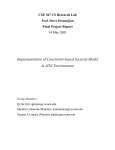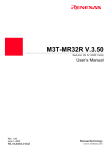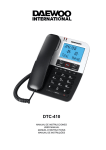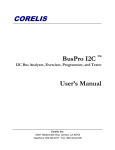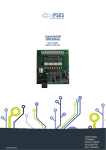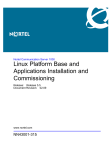Download Nokia M2M Platform M2M System Protocol 2 Socket
Transcript
USER MANUAL
Issue 1.0 9312023
Copyright © 2004 Nokia. All rights reserved.
NOKIA M2M PLATFORM
M2M SYSTEM PROTOCOL 2
SOCKET INTERFACE
Contents
ACRONYMS AND TERMS ...................................................................................................... 1
DEFINITIONS........................................................................................................................... 2
1. ABOUT THIS DOCUMENT ................................................................................................ 3
2. INTRODUCTION ................................................................................................................ 4
3. THE M2M SYSTEM PROTOCOL 2 SOFTWARE DESCRIPTION..................................... 6
3.1 SOCKET INTERFACE .................................................................................................. 6
3.2 NETWORK LINK LAYER .............................................................................................. 6
3.3 DATA LINK LAYER....................................................................................................... 6
3.4 PLATFORM WRAPPERS ............................................................................................. 7
4. INTEGRATING THE M2M SYSTEM PROTOCOL 2 WITH APPLICATION SOFTWARE.. 8
4.1 SOFTWARE IMPLEMENTATION................................................................................. 8
4.2 BUILDING THE SOFTWARE ....................................................................................... 9
4.3 PORTING THE SOFTWARE ........................................................................................ 9
5. THE M2M SYSTEM PROTOCOL 2 SOCKET INTERFACE............................................. 11
5.1 SOCKET API .............................................................................................................. 11
5.1.1
Creating a socket (sp2_socket) ......................................................................... 11
5.1.2
Binding a socket (sp2_bind) .............................................................................. 12
5.1.3
Listening to a socket (sp2_listen) ...................................................................... 13
5.1.4
Accepting a socket (sp2_accept)....................................................................... 15
5.1.5
Connecting a socket (sp2_connect) .................................................................. 16
5.1.6
Sending data to a socket (sp2_send / sp2_sendto) .......................................... 17
5.1.7
Receiving data from a socket (sp2_receive) ..................................................... 19
5.1.8
Closing a socket (sp2_close)............................................................................. 20
5.1.9
Resolve host information (sp2_gethostbyname) ............................................... 21
5.1.10 Network utility functions..................................................................................... 22
5.2 M2M SYSTEM PROTOCOL 2 CONTROL API........................................................... 22
5.2.1
Starting the M2M System Protocol 2 (sp2_start)............................................... 22
5.2.2
Stopping the M2M System Protocol 2 (sp2 _stop) ............................................ 24
5.3 WIRELESS LINK CONTROL API ............................................................................... 25
5.3.1
Opening a wireless link (sp2_link_open) ........................................................... 25
5.3.2
Closing a wireless link (sp2_link_close) ............................................................ 27
6. EXAMPLE OF M2M SYSTEM PROTOCOL 2 SOCKET USAGE..................................... 29
6.1 TYPICAL SOCKET USAGE........................................................................................ 29
6.1.1
Using a client socket.......................................................................................... 29
6.1.2
Using a server socket ........................................................................................ 30
6.2 APPLICATION SOFTWARE EXAMPLE ..................................................................... 31
6.2.1
Configuring and executing the Hello World application ..................................... 32
6.2.2
The Hello World implementation ....................................................................... 33
APPENDIX: NOKIA 12 GSM MODULE CONFIGURATION FOR THE HELLO WORLD
APPLICATION .................................................................................................................. 41
Legal Notice
Copyright © 2004 Nokia. All rights reserved.
Reproduction, transfer, distribution or storage of part or all of the contents in this document in any form without the
prior written permission of Nokia is prohibited.
Nokia and Nokia Connecting People are registered trademarks of Nokia Corporation. Java and all Java-based
marks are trademarks or registered trademarks of Sun Microsystems, Inc. Other product and company names
mentioned herein may be trademarks or trade names of their respective owners.
Nokia operates a policy of continuous development. Nokia reserves the right to make changes and improvements
to any of the products described in this document without prior notice.
Under no circumstances shall Nokia be responsible for any loss of data or income or any special, incidental,
consequential or indirect damages howsoever caused.
The contents of this document are provided "as is". Except as required by applicable law, no warranties of any
kind, either express or implied, including, but not limited to, the implied warranties of merchantability and fitness
for a particular purpose, are made in relation to the accuracy, reliability or contents of this document. Nokia
reserves the right to revise this document or withdraw it at any time without prior notice.
ACRONYMS AND TERMS
Acronym/term
Description
AM
Application Module
ANSI
American National Standards Institute
API
Application Programming Interface
CHAP
Challenge Handshake Authentication Protocol
DLL
Data Link Layer
IP
Internet Protocol
KB
Kilobyte (equivalent to 1024 bytes)
M2M
Machine-to-Machine (Man-to-Machine, Machine-toMan)
NLL
Network Link Layer
OS
Operating System
OSI
Open Systems Interconnection
Platform
Operating system and communication services
PPP
Point-to-Point Protocol
1/46
DEFINITIONS
Term
Description
Socket API
M2M System Protocol 2 API for socket operations
M2M System
Protocol 2 Control
API
M2M System Protocol 2 API for serial link control
Wireless Link Control
API
M2M System Protocol 2 API for GSM link control
Software wrapper
Used between software elements to isolate platformspecific features
2/46
1.
ABOUT THIS DOCUMENT
This document describes, from application software point of view, how to
integrate and use the M2M System Protocol 2. In addition to providing an
overview of the M2M System Protocol 2 software, the document includes
instructions on how to integrate the M2M System Protocol 2 with application
software and how to use the APIs of the M2M System Protocol 2 socket
interface. The document also includes an example of the M2M System Protocol
2 socket usage.
3/46
2.
INTRODUCTION
The M2M System Protocol 2 software provides a socket-programming interface
for application software. The socket interface may be used
•
locally between Application Module (AM) applications
•
to connect an AM application to a JavaTM IMlet running on the Nokia M2M
module
•
to connect an AM application to machines on the Internet or intranet via
wireless connectivity over the GSM network. The socket interface can also
be used to connect an AM application to other remote machines that use IP.
Because the IP protocol stack placed at the disposal of the socket interface is
located on the Nokia M2M module, application software must have a
connection to the Nokia M2M module services. As illustrated in Figure 1, the
M2M System Protocol 2 software is used to tunnel IP traffic between the AM
and the Nokia M2M module via a serial connection.
Application
Module
Nokia M2M
module
Application
software
M2M module
services
Wireless
connectivity
Socket
interface
M2M System
Protocol 2
software
Serial
connection
M2M System
Protocol 2
software
Figure 1. M2M System Protocol 2 overview
The socket interface provides a standard interface towards application
software. In addition to socket handling, the socket interface makes it possible
for the application to control both the wireless and serial connection. The M2M
System Protocol 2 software connects the AM to the Nokia M2M module via a
serial connection link, and enables the control of a M2M wireless connectivity
link.
The serial connection is a physical connection between the AM and Nokia M2M
module. It is connected between a serial port of the AM and the M2M System
Connector of the Nokia M2M module. The serial connection defines the lowest
layer transmission format using a point-to-point type of serial mode
transmission as described in the Nokia M2M Platform M2M System Protocol 2
Specification.
4/46
The wireless connectivity makes it possible to connect the Nokia M2M module
to a remote peer over a GSM network. Thus application software can be
connected to sockets located on remote machines. For more information on the
wireless connectivity solutions available via the Nokia M2M Platform, see the
Nokia M2M Platform Software Developer’s Guide.
5/46
3.
THE M2M SYSTEM PROTOCOL 2 SOFTWARE
DESCRIPTION
The M2M System Protocol 2 is based on the Open Systems Interconnection
(OSI) Reference Model. It is a set of layers organized in a hierarchical structure,
where each layer uses the layer below and provides services for the layer
above. When data is sent from application software to a network, it flows
downward the stack layer by layer until it has passed through the whole stack.
When the data reaches the bottom layer it is passed to a network. The data
received from the network flows the stack in an opposite direction. The software
structure of the M2M System Protocol 2 is illustrated in Figure 2.
Application software
Socket interface
Network Link Layer
Data Link Layer
Operating
system
wrapper
Operating
system
services
Serial communication wrapper
Serial communication services
Figure 2. M2M System Protocol 2 software structure
3.1
SOCKET INTERFACE
The socket interface is on the top level of the M2M System Protocol 2. It
provides all the services that application software uses for socket
communication over the network. For more information on the socket interface,
see Chapter 5.
3.2
NETWORK LINK LAYER
The Network Link Layer (NLL) is used to carry the M2M System Protocol 2
protocol primitives (requests/responses and indications/notifications) between
the AM and the Nokia M2M module. For more information on the NLL, see the
Nokia M2M Platform M2M System Protocol 2 Specification.
3.3
DATA LINK LAYER
The Data Link Layer (DLL) handles the transmission of protocol data packets
between the AM and the Nokia M2M module over a serial connection. For more
information on the DLL, see the Nokia M2M Platform M2M System Protocol 2
Specification.
6/46
3.4
PLATFORM WRAPPERS
The M2M System Protocol 2 is designed to operate in heterogeneous
environments where a variety of operating systems and different types of serial
communication hardware are used. The operating system and serial
communication wrappers separate platform-specific functionality from the
protocol stack in order to enhance the portability of the M2M System Protocol 2
implementation to different environments. For more information on the M2M
System Protocol 2 platform wrapping, see Chapter 4.
7/46
4.
INTEGRATING THE M2M SYSTEM PROTOCOL 2 WITH
APPLICATION SOFTWARE
This chapter describes how the M2M System Protocol 2 is integrated as a part
of application software.
4.1
SOFTWARE IMPLEMENTATION
The M2M System Protocol 2 is provided as ANSI-C implementation. The
software is composed of the socket interface, protocol stack (NLL/DLL), and
platform wrappers. Table 1 lists the header and source files of the M2M System
Protocol 2 software.
Table 1. The M2M System Protocol 2 implementation files
Module
Header files
Source files
Socket interface
sp2_control_api.h
sp2_control_api.c
sp2_socket_api.h
sp2_socket_api.c
sp2_link_api.h
sp2_link_api.c
sp2_socket.h
Protocol stack
Platform wrappers
sp2_nll.h
sp2_nll.c
sp2_dll.h
sp2_dll.c
sp2_rs.h
sp2_rs.c
sp2_port_socket.h
sp2_port_socket.c
sp2_system_common.h
sp2_system_common_win32.c
sp2_dbg_wrap.h
sp2_dbg_wrap_win32.c
sp2_port.h
sp2_port_os_win32.c
sp2_wait.h
sp2_port_hw_win32.c
sp2_types.h
Application software uses the M2M System Protocol 2 functions via the socket
interface. An application that uses the M2M System Protocol 2 functionality
must include the header file sp2_socket.h.
The protocol stack provides the core functionality of the M2M System Protocol
2. It is recommended that application software is designed not to use the
protocol stack directly.
The platform wrappers contain the platform-specific implementation of the
operating system and serial communication services for the M2M System
Protocol 2. The platform wrappers must be configured separately for each AM
platform.
8/46
Note: The M2M System Protocol 2 file names and external identifiers (except
‘system’ wrappers) are prefixed with ‘sp2’ to avoid name conflicts.
4.2
BUILDING THE SOFTWARE
This chapter provides a summary of how the M2M System Protocol 2 is built.
The instructions are written with the assumption that the reader is already
familiar with application software building process in general.
The M2M System Protocol 2 software building process includes the following
steps:
1. Select platform wrapper source files for the M2M System Protocol 2.
It is up to the application software developer to implement the AM platform
wrappers if they are not available. For more information on porting the M2M
System Protocol 2, see Chapter 4.3.
2. Compile all the M2M System Protocol 2 source files.
Compile the selected platform wrappers and all the socket interface/protocol
stack source files listed in Table 1. The socket interface and protocol stack
source files should compile without modifications.
3. Link the compiled files to application software
Once the M2M System Protocol source files are compiled (and optionally
linked as a library), they are linked with application software to produce the
final binary image.
Tip: Chapter 6.2.2 includes a sample makefile that can be used to get started with
building the M2M System Protocol 2 software.
4.3
PORTING THE SOFTWARE
As the M2M System Protocol 2 software is integrated with application software,
the AM itself must have enough resources for both the M2M System Protocol 2
and application software. As an example, the resource requirements for the
Win32 reference implementation of the M2M System Protocol 2 are listed in
Table 2.
Table 2. M2M System Protocol 2 resource requirements
Resource
Requirement
Threads
SenderThread, ReceiverThread, MsgQueueThread
RAM
Static 4 KB (+ thread stack) + dynamic approx. 20 KB
ROM
Approx. 64 KB
9/46
When the M2M System Protocol 2 is started it will create the SenderThread,
ReceiverThread, and MsgQueueThread. The SenderThread and
ReceiverThread are high priority serial drivers used for packet sending and
receiving, respectively. The MsgQueueThread takes care of serial message
delivery to/from the M2M System Protocol protocol stack and its priority is
application dependent.
The M2M System Protocol 2 memory requirements are approx. 64 KB ROM
(without system libraries) and approx. 4 KB RAM. In addition, some memory is
needed for dynamic memory and thread stacks. Dynamic memory size ranges
from a few kilobytes to a maximum of 30 kilobytes; depending mainly on serial
buffer sizes. The memory requirement for each thread stack is a few kilobytes.
Note: The Nokia M2M Platform M2M System Protocol 2 Specification also defines
a minimum implementation for resource-constrained AM devices. The Nokia M2M
module supports the minimum implementation.
10/46
5.
THE M2M SYSTEM PROTOCOL 2 SOCKET INTERFACE
The socket interface is divided into the following APIs: Socket API, M2M
System Protocol 2 Control API, and Wireless Link Control API. This chapter
describes the APIs and lists the related methods, parameters, and return
values. In addition, the chapter provides message sequence diagrams, which
illustrate message exchange caused by API calls between the AM and Nokia
M2M module.
For more detailed description of the messages, refer to the Nokia M2M Platform
M2M System Protocol 2 Specification.
Note: The M2M System Protocol 2 must be started before making any other M2M
System Protocol 2 API calls. For more information on how to start the M2M
System Protocol 2, see Chapter 5.2.1.
5.1
SOCKET API
The Socket API provides a standard socket interface. It supports client and
server sockets, and UDP/TCP protocols.
5.1.1
Creating a socket (sp2_socket)
The sp2_socket function creates a handle to a socket on the AM side of the
M2M System Protocol 2. The function call is illustrated in Figure 3.
Application software
M2M System Protocol 2
Nokia M2M module software
sp2_socket()
Create a socket
status()
Figure 3. Creating a socket
The parameters and return values of the sp2_socket function call are
described in Table 3 and Table 4.
Table 3. The sp2_socket function call parameters
Parameter
Description
Domain
IPv4
11/46
Parameter
Description
Type
Stream or datagram
Protocol
TCP or UDP
Table 4. The sp2_socket function call return values
Return value
Description
Socket ID
A handle to the created socket
SP2_SOCKET_ERROR
Socket allocation failed
An example of creating a socket:
DWORD socket; // a handle to the socket to be created
BYTE addrFormat = SP2_AF_INET; // addressing scheme is IPv4
BYTE type = SP2_SOCK_STREAM; // TCP stream socket
BYTE protocol = SP2_IPPROTO_TCP; // TCP/IP protocol is used
socket = sp2_socket(addrFormat,type,protocol);
if (socket != SP2_SOCKET_ERROR)
5.1.2
Binding a socket (sp2_bind)
The sp2_bind function binds a previously created M2M System Protocol 2
socket to a port. The function call is illustrated in Figure 4.
Application software
M2M System Protocol 2
Nokia M2M module software
sp2_bind()
Bind the
socket
status()
Figure 4. Binding a socket
The parameters and return values of the sp2_bind function call are described
in Table 5 and Table 6.
Table 5. The sp2_bind function call parameters
Parameter
Description
Socket ID
A handle to a socket to be bound
12/46
Parameter
Description
Address
The address of the socket to be bound
Address length
The length of the socket address in bytes
Table 6. The sp2_bind function call return values
Return value
Description
SP2_SOCKET_OK
Socket was bound successfully
SP2_SOCKET_ERROR
Socket binding failed
An example of binding a socket:
DWORD socketID; // a handle to the socket
DWORD status; // a return value from the function
struct sp2_sockaddr_in addr; // socket address structure for IPv4
addr.sin_family = SP2_AF_INET; // addressing scheme is IPv4
addr.sin_port = sp2_htons(1234); // port to which the socket is to be bound
addr.sin_addr = sp2_inet_addr(“127.0.0.1”); // a socket address
status = sp2_bind(socketID,(sp2_sockaddr *)&addr,sizeof(addr));
if (status == SP2_SOCKET_OK)
5.1.3
Listening to a socket (sp2_listen)
The sp2_listen function creates and binds a socket to the Nokia M2M
module, and initiates the listening of the incoming socket connection requests.
The function call is illustrated in Figure 5.
13/46
M2M System Protocol 2
Application software
Nokia M2M module software
sp2_listen()
SOCKET()
Create a socket
SOCKET_RESP()
* err_status()
BIND()
Bind the socket
BIND_RESP()
* err_status()
LISTEN()
Start listening
to the socket
LISTEN_RESP()
status()
Waiting for incoming
connection requests
* In case an error occurs, the function returns with an error status.
Figure 5. Listening to a socket
The parameters and return values of the sp2_listen function call are
described in Table 7 and Table 8.
Table 7. The sp2_listen function call parameters
Parameter
Description
Socket ID
A handle to a socket to be listened
Queue length
Connection queue length: 0..5
Table 8. The sp2_listen function call return values
Return value
Description
SP2_SOCKET_OK
Socket was connected successfully
14/46
Return value
Description
SP2_SOCKET_ERROR
Connection failure
An example of listening to a socket:
DWORD socketID; // a handle to the socket
DWORD status; // a return value from the function
DWORD queueLen = 1; // queue length is 1
status = sp2_listen(socketID,queueLen);
if (status == SP2_SOCKET_OK)
5.1.4
Accepting a socket (sp2_accept)
The sp2_accept function accepts an incoming socket connection. The
function will block until an ACCEPT_NOTIFICATION is received from the Nokia
M2M module. The function call is illustrated in Figure 6.
M2M System Protocol 2
Application software
Nokia M2M module software
sp2_accept()
Wait for an accept
notification
Listening to incoming
connection requests
ACCEPT_NOTIFICATION()
ACCEPT_NOTIFICATION_RESP()
status()
Figure 6. Accepting a socket
The parameters and return values of the sp2_accept function call are
described in Table 9 and Table 10.
Table 9. The sp2_accept function call parameters
Parameter
Description
Socket ID
A handle to a socket which is listened to
Address
The address of the incoming socket
Address length
The length of the socket address in bytes
Table 10. The sp2_accept function call return values
15/46
Return value
Description
Socket ID
A handle to an incoming socket
SP2_SOCKET_ERROR
Acceptance failure
An example of accepting a socket:
DWORD socketID; // a handle to the socket
DWORD acceptedSocketID; // a handle to an incoming socket
struct sp2_sockaddr_in addr; // incoming socket address structure
DWORD addrlen; // incoming socket address length
acceptedSocketID = sp2_accept(socketID,(sp2_sockaddr *)&addr,&addrlen);
if (acceptedSocketID != SP2_SOCKET_ERROR)
5.1.5
Connecting a socket (sp2_connect)
The sp2_connect function connects a previously created M2M System
Protocol 2 socket to another socket. The function call is illustrated in Figure 7.
Application software
M2M System Protocol 2
Nokia M2M module software
sp2_connect()
SOCKET()
Create a socket
SOCKET_RESP()
* err_status()
CONNECT()
Connect the socket
to a peer socket
status()
CONNECT_RESP()
* In case an error occurs, the function returns with an error status.
Figure 7. Connecting a socket
The parameters and return values of the sp2_connect function call are
described in Table 11 and Table 12.
Table 11. The sp2_connect function call parameters
16/46
Parameter
Description
Socket ID
A handle to a socket to be connected
Address pointer
The address of a socket to which the existing socket is
connected
Address length
The length of the socket address in bytes
Table 12. The sp2_connect function call return values
Return value
Description
SP2_SOCKET_OK
Socket was connected successfully
SP2_SOCKET_ERROR
Connection failure
An example of connecting a socket:
DWORD socketID; // a handle to the socket
DWORD status; // a return value from the function
struct sp2_sockaddr_in addr; // the address of the socket to be connected
addr.sin_family = SP2_AF_INET; // addressing scheme is IPv4
addr.sin_port = sp2_htons(1234); // port to which socket is to be connected
addr.sin_addr = sp2_inet_addr(“127.0.0.1”); // a socket address
status = sp2_connect(socketID,(sp2_sockaddr *)&addr,sizeof(addr));
if (status == SP2_SOCKET_OK)
5.1.6
Sending data to a socket (sp2_send / sp2_sendto)
The sp2_send and sp2_sendto functions write data to a previously
connected M2M System Protocol 2 socket. The sp2_send function is used with
TCP sockets, and the sp2_sendto function is used with UDP sockets. Both
function calls are illustrated in Figure 8.
M2M System Protocol 2
Application software
Nokia M2M module software
sp2_send / sp2_sendto()
SEND / SENDTO()
Start sending data
SEND_RESP()
status()
17/46
Figure 8. Sending data to a socket
The parameters of the sp2_send function call are described in Table 13.
Table 13. The sp2_send function call parameters
Parameter
Description
Socket ID
A handle to a socket to which data is written
Buffer
Data to be sent
Data length
The length of the data in bytes
Flags
Send flags
The parameters of the sp2_sendto function call are described in Table 14.
Table 14. The sp2_sendto function call parameters
Parameter
Description
Socket ID
A handle to the socket to which data is written
Buffer
Data to be sent
Data length
The length of the data in bytes
Flags
Send flags
Address
The address of the socket to which data is written
Address length
The length of the socket address in bytes
The return values of both the sp2_send and sp2_sendto function calls are
described in Table 15.
Table 15. The sp2_send and sp2_sendto function call return values
Return value
Description
Bytes written
Number of bytes written successfully
SP2_SOCKET_ERROR
Failure to write data
An example of sending data to a socket:
DWORD socketID; // the handle to the socket to which data is written
BYTE buff[DATA_LENGTH]; // buffer to store data to be written
DWORD nbytes = DATA_LENGTH; // number of bytes to be written
DWORD flags = 0; // no flags
DWORD bytesWritten; // number of bytes written successfully
bytesWritten = sp2_send(socketID,buff,nbytes,flags);
if (bytesWritten != SP2_SOCKET_ERROR)
18/46
5.1.7
Receiving data from a socket (sp2_receive)
The sp2_receive function instructs the Nokia M2M module to read data from
a socket. The sp2_receive will block and wait until data is available. The
function call is illustrated in Figure 9.
Application software
M2M System Protocol 2
Nokia M2M module software
sp2_receive()
RECEIVE()
RECEIVE_RESP()
* err_status()
Wait until data is available
RECEIVE_NOTIFICATION()
RECEIVE_NOTIFICATION_RESP()
status / data()
* In case an error occurs, the function returns with an error status.
Figure 9. Receiving data from a socket
The parameters and return values of the sp2_receive function call are
described in Table 16 and Table 17.
Table 16. The sp2_receive function call parameters
Parameter
Description
Socket ID
A handle to the socket from which data is read
Buffer
Buffer for the data to be read
Data length
The length of the data to be read in bytes
Flags
Receive flags
Table 17. The sp2_receive function call return values
Return value
Description
Bytes received
Number of bytes read successfully
SP2_SOCKET_ERROR
Failure to receive data
An example of receiving data from a socket:
19/46
DWORD socketID; // a handle to the socket
BYTE buff[DATA_LENGTH]; // buffer to store received data
DWORD nbytes = DATA_LENGTH; // number of bytes to be read
DWORD flags = 0; // no flags used
DWORD bytesRead; // number of bytes read successfully
bytesRead = sp2_receive(socketID,buff,nbytes,flags);
if (bytesRead != SP2_SOCKET_ERROR)
5.1.8
Closing a socket (sp2_close)
The sp2_close function releases a socket handle and instructs the Nokia
M2M module to close a socket. The function call is described in Figure 10.
M2M System Protocol 2
Application software
Nokia M2M module software
sp2_close()
CLOSE()
Close the socket
CLOSE_RESP()
status()
Close the socket
Figure 10. Closing a socket
The parameters and return values of the sp2_close function call are
described in Table 18 and Table 19.
Table 18. The sp2_close function call parameters
Parameter
Description
Socket ID
A handle to the socket to be closed
Table 19. The sp2_close function call return values
Return value
Description
SP2_SOCKET_OK
Socket was closed successfully
SP2_SOCKET_ERROR
Failure to close a socket
An example of closing a socket:
20/46
DWORD socketID; // a handle to the socket
DWORD status; // a return value from the function
status = sp2_close(socketID);
if (status == SP2_SOCKET_OK)
5.1.9
Resolve host information (sp2_gethostbyname)
The sp2_gethostbyname function resolves host information based on domain
name. The function call is illustrated in Figure 11.
Application software
M2M System Protocol 2
Nokia M2M module software
sp2_gethostbyname()
GETHOSTBYNAME_REQ()
Resolve host information
GETHOSTBYNAME_RESP()
status()
Figure 11. Resolving host information
The parameters and return values of the sp2_gethostbyname function call
are described in Table 20 and Table 21.
Table 20. The sp2_gethostbyname function call parameters
Parameter
Description
String
A domain name to be resolved
Table 21. The sp2_gethostbyname function call return values
Return value
Description
Host information
Host information was resolved successfully
NULL
Failure to resolve a host
An example of resolving host information:
struct hostent *host; // function gethostbyname will reserve memory
const char *hostname = “local”; // a domain name
host = sp2_gethostbyname(hostname);
if (host != NULL)
21/46
{
// use the host information and then release allocated memory
free(host->h_name); // name string must be released by caller
free(host); // host struct must be released by caller finally
}
5.1.10
Network utility functions
The M2M System Protocol 2 also provides some utility functions that are
typically used when programming sockets. The utility functions are described
below.
Convert a 32-bit value from host byte order to network byte order:
DWORD sp2_htonl(DWORD hostlong);
Convert a 16-bit value from host byte order to network byte order:
WORD sp2_htons(WORD hostshort);
Convert a 32-bit value from network byte order to host byte order:
DWORD sp2_ntohl(DWORD netlong);
Convert a 16-bit value from network byte order to host byte order:
WORD sp2_ntohs(WORD netshort);
Convert an IPv4 address from a dotted decimal string to 32-bit network byte
ordered value:
DWORD sp2_inet_addr(const char *addr);
Convert a 32-bit network byte ordered IPv4 address to dotted decimal string:
char
5.2
*sp2_inet_ntoa(DWORD naddr);
M2M SYSTEM PROTOCOL 2 CONTROL API
The M2M System Protocol 2 Control API makes it possible to configure, open
and close of a link between the AM and Nokia M2M module.
5.2.1
Starting the M2M System Protocol 2 (sp2_start)
The sp2_start function is used to establish an M2M System Protocol 2 link
between the AM and Nokia M2M module.
22/46
Note: The sp2_start function must be executed and the
sp2_hLinkReadyEvent must be received before any other M2M System
Protocol 2 API call can be made.
The sp2_start function configures the DLL according to the parameters
given, and then starts the M2M System Protocol 2 threads. The function call is
illustrated in Figure 12.
Application software
M2M System Protocol 2
Nokia M2M module software
sp2_start()
status()
Configure DLL parameters
and start the threads.
sp2_reset()
RESET()
* Reset the NLL
RESET_RESP()
* Reset the NLL
status()
* Clear packet sequence numbers, abort pending transactions, and close all sockets.
Figure 12. Starting the M2M System Protocol 2
The parameters and return values of the sp2_start function call are
described in Table 22 and Table 23.
Table 22. The sp2_start function call parameters
Parameter
Description
N1
M2M System Protocol 2 parameter N1: 50..255
N3
M2M System Protocol 2 parameter N3: 5..10
T3
M2M System Protocol 2 parameter T3: 1..15s
Port
Serial port number used for data link connection
Baud rate
Baud rate (bit/s) used: 9600, 19200, 38400, 57600,
115200
23/46
Note: Typically only the port and baud rate parameters are modified. The
recommended values for the N1, N3, and T3 parameters are 255, 10, and 5,
respectively. For more information on modifying the N1, N3, and T3 parameter
values, see the Nokia M2M Platform M2M System Protocol 2 Specification.
Table 23. The sp2_start function call return values
Return value
Description
SP2_OK
M2M System Protocol 2 was started successfully
SP2_ERROR
Failure to start the M2M System Protocol 2
An example of starting a M2M System Protocol 2 link:
BYTE n1 = 255; // maximum data field length: n = 16*(N1+1)
BYTE n3 = 10; // activity timer is 10s
BYTE t3 = 5; // system protocol parameter T3
BYTE port = 1; // use COM port 1
DWORD baudrate = 115200; // serial speed is 115200 bps
DWORD status; // a return value from the function
status = sp2_start(n1,n3,t3,port,baudrate);
if (status == SP2_OK)
5.2.2
Stopping the M2M System Protocol 2 (sp2 _stop)
The sp2_stop function is used to stop an M2M System Protocol 2 link
between the AM and Nokia M2M module. The function call is described in
Figure 13.
Note: After this function is called and the stop event is received, the M2M
System Protocol 2 resources are freed, and the protocol must be restarted before
issuing any further API requests.
24/46
Application software
M2M System Protocol 2
Nokia M2M module software
sp2_stop()
RESET()
RESET_RESP()
status()
Reset the NLL
Stop all active operations
and release all resources.
Figure 13. Stopping the M2M System Protocol 2
The sp2_stop function call does not have any parameters. The return values
are described in Table 24.
Table 24. The sp2_stop function call return values
Return value
Description
SP2_OK
Link was stopped successfully
SP2_ERROR
Failure to stop a link
An example of stopping a M2M System Protocol 2 link:
DWORD status; // a return value from the function
status = sp2_stop();
if (status == SP2_OK)
5.3
WIRELESS LINK CONTROL API
The Wireless Link Control API makes it possible to open and close a preconfigured connection of the Nokia M2M module. Since the configuration
cannot be changed via the Wireless Link Control API, the connection
configuration must be done either locally using the Configurator software for the
Nokia M2M module or remotely over-the-air via the Nokia M2M Gateway.
5.3.1
Opening a wireless link (sp2_link_open)
The sp2_link_open function is used to establish a wireless link over a GSM
network via the Nokia M2M module. The sp2_link_open function call is
illustrated in Figure 14.
25/46
Application software
M2M System Protocol 2
Nokia M2M module software
sp2_link_open()
LINK_OPEN()
LINK_OPEN_RESP()
* err_status()
Open the link
LINK_NOTIFICATION()
LINK_NOTIFICATION_RESP()
status()
* In case an error occurs, the function returns with an error status.
Figure 14. Opening a wireless link
The parameters of the sp2_link_open function call are described in Table 25.
The return values from the sp2_link_open function call are described in
Table 26.
Table 25. The sp2_link_open function call parameters
Parameter
Description
Connection ID
The Nokia M2M module connection ID to be checked
and opened.
Table 26. The sp2_link_open function call return values
Return value
Description
Link ID
Handle to an opened link
SP2_LINK_ERROR
Failure to open a link
An example of opening a wireless link:
DWORD connectionID = SP2_DEFAULT_CONNECTION; // preconfigured connection ID
DWORD linkID; // a handle to the link that was opened
linkID = sp2_link_open(connectionID);
if (linkID != SP2_LINK_ERROR)
26/46
5.3.2
Closing a wireless link (sp2_link_close)
The sp2_link_close function is used to close a wireless link over a GSM
network via the Nokia M2M module. The function call is depicted in Figure 15.
Note: All remote sockets must be closed before closing the wireless link.
Application software
M2M System Protocol 2
Nokia M2M module software
sp2_link_close()
LINK_CLOSE()
LINK_CLOSE_RESP()
* err_status / status()
Close the link
LINK_NOTIFICATION()
LINK_NOTIFICATION_RESP()
status()
* In case an error occurs, the function returns with an error status.
Note: If the link is already closed, the sp2_link_close call will return immediately,
and LINK_NOTIFICATION is not used.
Figure 15. Closing a wireless link
The parameters and return values of the sp2_link_close function call are
described in Table 27 and Table 28.
Table 27. The sp2_link_close function call parameters
Parameter
Description
Link ID
Link ID to be closed
Table 28. The sp2_link_close function call return values
Return value
Description
SP2_LINK_OK
Link was closed successfully
SP2_LINK_ERROR
Failure to close a link
An example of closing a wireless link:
27/46
DWORD linkID; // a handle to the link
if (sp2_link_close(linkID) == SP2_LINK_OK)
28/46
6.
EXAMPLE OF M2M SYSTEM PROTOCOL 2 SOCKET
USAGE
6.1
TYPICAL SOCKET USAGE
Sockets are typically used for client-server communication. This chapter
describes the typical use of the M2M System Protocol 2 client and server
sockets. Although the sequences are illustrated from an individual socket’s
point of view, one M2M System Protocol 2 session and wireless GSM link may,
of course, be used for many different sockets.
6.1.1
Using a client socket
Typically application software that uses a M2M System Protocol 2 client socket
over wireless connectivity has to:
1. Open a serial link to the Nokia M2M module via the M2M System Protocol 2
Control API.
2. Reset the protocol via the M2M System Protocol 2 Control API.
3. Open a wireless GSM link via the Wireless Link Control API.
4. Communicate with the server application via the Socket API.
5. Close the wireless link via the Wireless Link Control API
6. Close the serial link to the Nokia M2M module via the M2M System Protocol 2
Control API.
A typical client socket message sequence is illustrated in Figure 16.
29/46
Socket client
M2M System Protocol 2
Start M2M System Protocol 2()
* Open a wireless link()
* Wireless link opened notification()
Create a socket()
** Connect the socket()
Data sending and receiving()
Close the socket()
* Close the wireless link()
* Wireless link closed notification()
Stop M2M System Protocol 2()
* Wireless link is not used for local sockets.
** Connect is required only for stream sockets.
Figure 16. A typical client socket message sequence
Note: In case the wireless link breaks all new and pending socket functions using
the link in question will fail. To execute the socket operations that were
interrupted, the wireless link has to be re-established and the sockets have to be
closed and recreated.
6.1.2
Using a server socket
Unlike with client sockets, server sockets do not need to control wireless GSM
links. Instead, the Nokia M2M module handles wireless links automatically.
Typically application software that uses a M2M System Protocol 2 server socket
has to:
1. Open a serial link to the Nokia M2M module via the M2M System Protocol 2
Control API.
2. Reset the M2M System Protocol 2 via the M2M System Protocol 2 Control
API.
3. Wait for an incoming socket request via the Socket API.
30/46
4. Communicate with the client via the Socket API.
5. Close the serial link to the Nokia M2M module via the M2M System Protocol 2
Control API.
A typical server socket message sequence is illustrated in Figure 17.
Socket server
M2M System Protocol 2
Start M2M System Protocol 2()
Create a server socket()
Bind the server socket()
Listen to the server socket()
Accept a client socket()
A client socket accepted()
Data sending and receiving()
Close the client socket()
Close the server socket()
Stop M2M System Protocol 2()
Figure 17. A typical server socket message sequence
Note: In case the serial link between the AM and Nokia M2M module is reestablished after being broken, the M2M System Protocol 2 will reset the protocol;
all pending operations are interrupted, and all sockets are closed.
6.2
APPLICATION SOFTWARE EXAMPLE
In this chapter, the Hello World application uses the M2M System Protocol 2
client and server sockets as described in Chapter 6.1. Figure 18 shows an
overview of the Hello World application, in which the M2M System Protocol 2
socket interface is used to send a text string “SAY” from the client to the server,
and a text string “HELLO WORLD!” back from the server to the client.
31/46
HelloWorld Client
M2M System Protocol 2
HelloWorld Server
Start M2M System Protocol 2
M2M System Protocol 2 started event
Start HelloWorld Server
Create a server socket
Bind the socket
Listen to the socket
Server started event
Wait a socket connection
Create a socket
Connect the socket
A client socket accepted
Try to receive data
Send "SAY"
Received "SAY"
Try to receive data
Received "HELLO WORLD!"
Display the text "HELLO
WORLD!" on the screen
Send "HELLO WORLD!"
Close the client socket
Close the server socket
Close the socket
Stop M2M System Protocol 2
M2M System Protocol 2 stopped event
Figure 18. Overview of the Hello World application
6.2.1
Configuring and executing the Hello World application
The Hello World application includes both the client and server
implementation. As both the client and server of the Hello World application
use the M2M System Protocol 2 sockets, the socket peers are likely to be Nokia
M2M modules. Thus, the wireless connection between the two Nokia M2M
modules has to be configured so that the client can establish a connection to
the server.
32/46
Note: An example configuration (for the Nokia 12 GSM module) is presented in
Appendix: Nokia 12 GSM module configuration for the Hello World application.
When executing the Hello World application, the server must be initialized
first; it must be ready to accept incoming socket connections from the client.
The Hello World application can be executed, for example, from the
command prompt.
Use the following parameters to execute the Hello World server:
> HelloWorld.exe server <com port>
Use the following parameters to execute the Hello World client:
> HelloWorld.exe client <com port>
When the Hello World application is executed without errors, the client will
display the text “Hello World successful!” on the screen. If an error occurs, the
client will display an error message with a failure explanation.
6.2.2
The Hello World implementation
In the Hello World implementation, the M2M System Protocol 2 serial link is
initialized first. When the client receives a link ready indication, it tries to
establish a connection to the server that is listening to incoming sockets. After
the server has accepted the connection request, the client will write the text
string “SAY” to the socket. The server reads the text from its socket and answers
with a text string “HELLO WORLD!”. Finally, the client receives the server’s greeting
through its socket and displays the text on the screen. Listing 1 shows the
source code of the Hello World application.
Listing 1. Hello World – an M2M System Protocol 2 example
// Hello World application: HelloWorld.c
// This is an example of how to use the M2M System Protocol 2 in Win32.
// See the M2M System Protocol 2 Integrator's Manual for more
// information about this software.
// Usage: HelloWorld.exe client/server <com port>
// Expected output: “Hello World successful!” or an error message
#include <stdio.h>
// The M2M System Protocol 2 Socket interface
#include "sp2_socket.h"
// Size of buffer that holds text messages: "SAY" and "HELLO WORLD!"
#define messageBufferLen 80
static const WORD TcpPortThatServerIsListening = 0x5555;
33/46
// Client functionality
static BOOL HelloWorldClient(void);
// Server functionality
static BOOL HelloWorldServer(void);
// The function for writing a '\0' char terminated text string to a socket
static BOOL sendMessage(DWORD socket, const char *msg);
// The function for reading a '\0' char terminated string from a socket
static BOOL receiveMessage(DWORD socket, char *messageBuffer, int size);
// Cleanup and exit Hello World (just a convenience function)
static void cleanExit(int statusId, char *statusName);
// This source file has both server and client functionality.
// The first command line argument tells which role is chosen
static BOOL isClient;
// Main entry of the Hello World application
void main(int argc, char * argv[])
{
// Serial port parameters
BYTE COMPort;
LONG COMPortSpeed = 115200;
if (argc != 3)
{
cleanExit(0,"Usage: helloworld client/server <com port>");
}
if (strcmp(argv[1],"client") == 0)
{
isClient = TRUE;
} else
{
isClient = FALSE; // i.e. isServer
}
COMPort = (BYTE)atoi(argv[2]);
if (isClient)
{
printf("HelloWorld Client at COM port %d\r\n",COMPort);
} else
{
printf("HelloWorld Server at COM port %d\r\n",COMPort);
}
//
//
//
if
{
At first, create the M2M System Protocol 2 hLinkReadyEvent;
the hLinkReadyEvent is used by the M2M System Protocol 2 to
indicate when the link between the AM and Nokia M2M module is ready.
(!system_event_create(&sp2_hLinkReadyEvent) || !sp2_hLinkReadyEvent)
cleanExit(10,"ERROR: Cannot create hLinkReadyEvent");
}
// The hStopEvent is used by the M2M System Protocol 2 to indicate
// when the link between the AM and Nokia M2M module is stopped.
if (!system_event_create(&sp2_hStopEvent) || !sp2_hStopEvent)
{
cleanExit(20,"ERROR: Cannot create hStopEvent");
}
// Start the M2M System Protocol 2
if (!sp2_start(255,10,5,COMPort,COMPortSpeed))
{
cleanExit(30,"ERROR: Cannot start M2M System Protocol 2");
}
// Wait until the M2M System Protocol 2 has started (the timeout is 3
// seconds)
if (system_event_wait(sp2_hLinkReadyEvent,3*1000) != SYSTEM_OK)
34/46
{
cleanExit(40,"ERROR: hLinkReadyEvent not OK");
}
// When a link is ready the protocol state must be reset.
if (!sp2_reset())
{
cleanExit(50,"ERROR: Cannot reset the M2M System Protocol 2");
}
// Select the role: client or server.
if (isClient)
{
// Server should be ready before doing client's job
if (!HelloWorldClient())
{
cleanExit(60,"ERROR: HelloWorldClient failed!");
}
} else
{
if (!HelloWorldServer())
{
cleanExit(60,"ERROR: HelloWorldServer failed!");
}
}
// Give some time for the system to send messages
Sleep(10*1000);
// Stop the M2M System Protocol 2
if (!sp2_stop())
{
cleanExit(-10,"ERROR: Cannot stop M2M System Protocol 2!");
}
// The hStopEvent indicates that the M2M System Protocol 2 is stopped.
if (system_event_wait(sp2_hStopEvent,30*1000) != SYSTEM_OK)
{
cleanExit(-20,"ERROR: M2M System Protocol 2 was not stopped!");
}
// Close all handles before exiting.
if (!CloseHandle(sp2_hLinkReadyEvent) ||
!CloseHandle(sp2_hStopEvent))
{
cleanExit(-30,"ERROR: Cannot close all handles!");
}
cleanExit(0,"Hello World successful!");
}
// The functionality of the Hello World client.
static BOOL HelloWorldClient(void)
{
DWORD socket; // A client socket handle
sp2_sockaddr_in socketAddress; // The address of the socket
BOOL success = FALSE; // Indicates Hello World client’s success/failure
DWORD linkID; // A wireless link handle
DWORD connectionID = SP2_DEFAULT_CONNECTION;
// Please note that wireless link is not needed for local sockets
if ((linkID = sp2_link_open(connectionID)) == SP2_LINK_ERROR)
{
printf("sp2_link_open failed\n");
return FALSE;
}
// Create an M2M System Protocol 2 socket
35/46
socket = sp2_socket(SP2_AF_INET, SP2_SOCK_STREAM, SP2_IPPROTO_TCP);
if(socket != SP2_SOCKET_ERROR)
{
socketAddress.sin_family = SP2_AF_INET;
socketAddress.sin_port = sp2_htons(TcpPortThatServerIsListening);
socketAddress.sin_addr = sp2_inet_addr("10.0.0.1");
if(sp2_connect(socket,(sp2_sockaddr*)&socketAddress,
sizeof(socketAddress)) != SP2_SOCKET_ERROR)
{
const char *sayString = "SAY";
printf("Client: send message: %s\n", sayString);
if (sendMessage(socket, sayString))
{
char messageBuffer[messageBufferLen];
if (receiveMessage(socket, messageBuffer, messageBufferLen))
{
printf("Client: got message: %s\n ", messageBuffer);
if (strcmp(messageBuffer,"HELLO WORLD!") == 0)
{
success = TRUE;
}
} else
{
printf ("ERROR: Client receiveMessage\n");
}
} else
{
printf ("ERROR: Client sp2_send\n");
}
} else
{
printf ("ERROR: Client sp2_connect\n");
}
if (sp2_close(socket) == SP2_SOCKET_ERROR)
{
printf ("ERROR: Client sp2_close\n");
}
} else
{
printf ("ERROR: Client sp2_socket\n");
}
// Remember to close the wireless link (if opened earlier)
if (sp2_link_close(linkID) != SP2_LINK_OK)
{
printf ("ERROR: Client sp2_link_close\n");
}
return success;
}
// The functionality of the Hello World server.
static BOOL HelloWorldServer(void)
{
DWORD serverSocket; // A server socket handle
DWORD socket = SP2_SOCKET_ERROR; // A data socket handle from the client
sp2_sockaddr_in socketAddress; // Socket address structure
DWORD addrLen; // Socket address length
// Create an M2M System Protocol 2 socket for the server to start
// listening to client connections.
serverSocket = sp2_socket(SP2_AF_INET,SP2_SOCK_STREAM,SP2_IPPROTO_TCP);
if(serverSocket != SP2_SOCKET_ERROR)
{
socketAddress.sin_family = SP2_AF_INET;
36/46
socketAddress.sin_port = sp2_htons(TcpPortThatServerIsListening);
socketAddress.sin_addr = 0;
if(sp2_bind(serverSocket, (sp2_sockaddr *)&socketAddress,
sizeof(socketAddress)) != SP2_SOCKET_ERROR)
{
if(sp2_listen(serverSocket, 0x00) != SP2_SOCKET_ERROR)
{
// The server is now ready to receive socket connections
addrLen = sizeof(socketAddress);
socket = sp2_accept(serverSocket,
(sp2_sockaddr *)&socketAddress, &addrLen);
if(socket != SP2_SOCKET_ERROR)
{
char messageBuffer[messageBufferLen];
if (receiveMessage(socket, messageBuffer,
messageBufferLen))
{
printf("Server: got message: %s\n ", messageBuffer);
if (strcmp("SAY",messageBuffer) == 0)
{
const char *helloWorldString = "HELLO WORLD!";
printf ("Server: send message: %s\n",
helloWorldString);
if (sendMessage(socket, helloWorldString))
{
// give system time to send message
Sleep(3*1000);
} else
{
printf ("ERROR: Server sp2_send\n");
return FALSE;
}
}
} else
{
printf ("ERROR: Server receiveMessage\n");
return FALSE;
}
if (sp2_close(socket) == SP2_SOCKET_ERROR)
{
printf ("ERROR: Server sp2_close\n");
return FALSE;
}
}
}
else
{
printf ("ERROR: Server sp2_listen\n");
return FALSE;
}
}
else
{
printf ("ERROR: Server sp2_bind\n");
return FALSE;
}
}
else
{
printf ("ERROR: Server sp2_socket\n");
return FALSE;
}
if (sp2_close(serverSocket) == SP2_SOCKET_ERROR)
{
printf ("ERROR: Server socket sp2_close\n");
return FALSE;
}
37/46
return TRUE;
}
// The function for writing a '\0' char terminated text string to a socket
BOOL sendMessage(DWORD socket, const char *msg)
{
int bytesSent = 0;
int size = strlen(msg)+1;
while (bytesSent != size)
{
// Send data to the M2M System Protocol 2.
// Hello World messages are very short and thus probably sent
// in one request. However, the number of bytes written is checked
// and sending is looped until all the data has been sent.
int n = sp2_send(socket, msg+bytesSent, size-bytesSent, 0x00);
if (n == SP2_SOCKET_ERROR)
{
printf("ERROR: sp2_send\n");
return FALSE;
}
bytesSent += n;
Yield(); // Just to let other threads run
}
return TRUE;
}
// The function for reading a '\0' char terminated string from a socket
BOOL receiveMessage(DWORD socket, char *messageBuffer, int size)
{
int bytesReceived = 0;
BOOL isMessageReceived = FALSE;
// Read until the '\0' char is received.
while (!isMessageReceived)
{
// Receive data from the M2M System Protocol 2.
// Hello World messages are very short and thus probably received
// in one request. However, the number of bytes read is checked
// and receiving is looped until all the data has been received.
int n = sp2_receive(socket, messageBuffer+bytesReceived,
size - bytesReceived, 0x00);
if (n == SP2_SOCKET_ERROR)
{
printf("ERROR: sp2_receive\n");
return isMessageReceived;
} else
{ // Check whether the '\0' char was received.
int i;
for (i=bytesReceived; i<bytesReceived+n; i++)
{
if (messageBuffer[i] == 0)
{
isMessageReceived = TRUE;
}
}
bytesReceived += n;
}
Yield(); // Let other threads run
}
return isMessageReceived;
}
// Do the cleanup and then exit.
void cleanExit(int statusId, char *statusName)
{
38/46
printf("%s\n",statusName);
switch (statusId)
{
// Successful case!
case 0:
break;
// Error cases:
case -10:
// flow-thru
case -20:
CloseHandle(sp2_hLinkReadyEvent);
CloseHandle(sp2_hStopEvent);
// flow-thru
case -30:
break;
case 60:
// flow-thru
case 50:
// flow-thru
case 40:
// flow-thru
if (sp2_stop())
{
system_event_wait(sp2_hStopEvent,10*1000);
}
// flow-thru
case 30:
system_event_destroy(sp2_hStopEvent);
// flow-thru
case 20:
system_event_destroy(sp2_hLinkReadyEvent);
// flow-thru
case 10:
break;
default:
printf("Unknown ERROR at cleanExit: %d\n",statusId);
break;
}
// The statusId is passed to ExitProcess and it can be acquired by
// using the Win32 GetExitCodeThread function (success = 0)
ExitProcess(statusId);
}
To use the M2M System Protocol 2 functions from an application the M2M
System Protocol 2 objects must be included within application software. Listing
2 shows a makefile template that lists the Hello World and M2M System
Protocol 2 object files.
Listing 2. A sample makefile for the M2M System Protocol 2
# Makefile template for the M2M System Protocol 2 (Win32 port)
# List all the objects of the M2M System Protocol 2
# Notice that Win32-specific file names end with “win32”
SP2_OBJS = sp2_control_api.o sp2_socket_api.o sp2_link_api.o \
sp2_common.o sp2_rs.o sp2_dll.o sp2_nll.o sp2_port_socket.o \
sp2_port_os_win32.o sp2_port_hw_win32.o \
sp2_system_common_win32.o sp2_dbg_wrap_win32.o
# Target ‘all’ contains application software objects instead
39/46
# of HelloWorld.o in application module software makefile
all: $(SP2_OBJS) HelloWorld.o
Tip: The Hello World makefile is a good starting point when integrating the M2M
System Protocol 2 with application software.
40/46
APPENDIX: NOKIA 12 GSM MODULE CONFIGURATION FOR THE
HELLO WORLD APPLICATION
This chapter provides an example of how to use the Nokia 12 Configurator to
configure two Nokia 12 GSM modules as a client and a server. The
configuration presented in this chapter has to be carried out in order for the
Hello World client to establish a connection to the Hello World server.
The Hello World server configuration
The incoming Challenge Handshake Authentication Protocol (CHAP) for the
Point-to-Point Protocol (PPP) must be configured for the server.
1. Select Bearer Selection from the M2M System Mode menu.
2. Define the incoming CHAP username and password (for example,
ntn211/ntn211).
An example configuration is shown in Figure 19.
Figure 19. The Hello World server configuration for client authentication
The connection of the server must be configured so that the server is ready to
accept incoming requests from the Hello World client. In this example the client
will be configured so that it makes a TCP CSD call and that is why the wireless
bearer of the server is configured to use TCP CSD.
3. Select Connection 1 from the M2M Bearer Selection dialog.
41/46
4. Choose TCP CSD as the wireless bearer.
An example configuration is shown in Figure 20.
Figure 20. The Hello World server connection configuration
You also have to configure the IP address of the server. The IP address that is
configured to the server must match with the IP address that the client uses as
a parameter for the M2M System Protocol 2 sp2_connect function.
5. Select Cable from the IMlet loading menu.
6. Write 10.0.0.1 as the Nokia 12 IP address.
An example IP address configuration for the server is shown in Figure 21.
42/46
Figure 21. Hello World server IP address configuration
The Hello World client configuration
In the Hello World example, the client is configured so that it makes a direct
TCP CSD call to the server. Therefore you need to configure a TCP CSD
connection for the client; the client opens the default connection when it
connects to the server.
1. Select Bearer Selection from the M2M System Mode menu.
2. Choose the default connection (for example Connection 1).
An example configuration is shown in Figure 22.
43/46
Figure 22. The Hello World client default connection configuration
A wireless connection (from the client to the server) has to be configured for the
client. The outgoing CHAP configuration of the client must match with the
incoming CHAP configuration of the server in order for the server to make a
client authentication. In addition, the phone number of the server is defined in
the ‘Gateway number’ field because the client calls the Gateway number to
establish a data connection to the server.
3.
Select Connection 1 from the M2M Bearer Selection dialog.
4. Choose TCP CSD as the wireless bearer.
5. Define the outgoing CHAP username and password (for example
ntn211/ntn211).
6. Define the phone number of the server (for example +123xxxxx).
A wireless connection configuration example for the client is shown in Figure
23.
44/46
Figure 23. Hello World client configuration for a wireless connection
Note: In this example the data call is dropped if there is a 300 second pause in
the data traffic (connection timeout is set to 300 s).
And finally, you also have to configure the IP address of the client. The IP
address that is configured to the client can be any valid host IP address, for
example 10.0.0.2.
7. Select Cable from the IMlet loading menu.
8. Write 10.0.0.2 as the Nokia 12 IP address.
An example IP address configuration for the client is shown in Figure 24.
45/46
Figure 24. Hello World client IP address configuration
46/46


















































